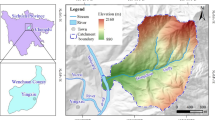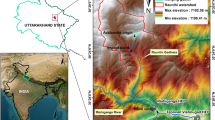Abstract
On 13 August 2010, a catastrophic debris flow with a volume of 1.17 million m3 occurred in Xiaojiagou Ravine near Yingxiu town of Wenchuan county in Sichuan Province, China. The main source material was the landslide deposits retained in the ravine during the 2008 Wenchuan earthquake. This paper describes a two-dimensional hybrid numerical method that simulates the entire process of the debris flow from initiation to transportation and finally to deposition. The study area is discretized into a grid of square zones. A two dimensional finite difference method is then applied to simulate the rainfall-runoff and debris flow runout processes. The analysis is divided into three steps; namely, rainfall-runoff simulation, mixing water and solid materials, and debris flow runout simulation. The rainfall-runoff simulation is firstly conducted to obtain the cumulative runoff near the location of main source material and at the outlet of the first branch. The water and solid materials are then mixed to create an inflow hydrograph for the debris flow runout simulation. The occurrence time and volume of the debris flow can be estimated in this step. Finally the runout process of the debris flow is simulated. When the yield stress is high, it controls the deposition zone. When the yield stress is medium or low, both yield stress and viscosity influence the deposition zone. The flow velocity is largely influenced by the viscosity. The estimated yield stress by the equation, τ y = ρghsin θ, and the estimated viscosity by the equation established by Bisantino et al. (2010) provide good estimates of the area of the debris flow fan and the distribution of deposition depth.
Similar content being viewed by others
References
Bisantino T, Fischer P, Gentile F (2010) Rheological characteristics of debris-flow material in South-Gargano watersheds. Natural Hazards 54: 209–23.
Boss Corporation (1989) DAMBRK-User’s Manual. Boss International Inc., Madison, Wisconsin, USA.
Četina M, Rajar R, Hojnik T, et al. (2006) Case study: numerical simulations of debris flow below Stože, Slovenia. Journal of Hydraulic Engineering 132: 121–130.
Chen L, Young MH (2006) Green-Ampt infiltration model for sloping surfaces. Water Resources Research 42(7): W07420.
Chen HX, Zhang LM, Chang DS, et al. (2012) Mechanisms and runout characteristics of the rainfall-triggered debris flow in Xiaojiagou in Sichuan Province, China. Natural Hazards 62(3): 1037–1057.
Cui P, Wei FQ, Xie H, et al. (2003) Debris flow and disaster reduction strategies in western China. Quaternary Science 23(2): 142–151. (In Chinese)
Cui P, Chen XQ, Zhu YY, et al. (2011a) The Wenchuan earthquake (May 12, 2008), Sichuan province, China, and resulting geohazards. Natural Hazards 56: 19–36.
Cui P, Hu KH, Zhuang JQ, et al. (2011b) Prediction of debrisflow danger area by combining hydrological and inundation simulation methods. Journal of Mountain Science 8: 1–9.
FLO-2D Software Inc. (2009) FLO-2D reference manual. Nutrioso, Arizona, USA.
Fraccarollo L, Papa M (2000) Numerical simulation of real debris-flow events. Physics and Chemistry of the Earth, Part B: Hydrology, Oceans and Atmosphere 25: 757–763.
Huang X, Garcia MH (1998) A Herschel-Bulkley model for mud flow down a slope. Journal of Fluid Mechanics 374: 305–333.
Hungr O (1995) A model for the runout analysis of rapid flow slides, debris flows, and avalanches. Canadian Geotechnical Journal 32: 610–623.
Li MH, Sung RT, Dong JJ, et al. (2011) The formation and breaching of a short-lived landslide dam at Hsiaolin Village, Taiwan-part II: simulation of debris flow with landslide dam breach. Engineering Geology 123: 60–71.
O’Brien JS, Julien PY (1988) Laboratory analysis of mudflow properties. Journal of Hydraulic Engineering 114: 877–887.
O’Brien JS, Julien PY, Fullerton WT (1993) Two-dimensional water flood and mudflow simulation. Journal of Hydraulic Engineering 119: 244–261.
Peng M, Zhang LM (2012) Breaching parameters of landslide dams. Landslides 9: 13–31.
Rawls WJ, Brakensiek DL, Miller N (1983) Green-Ampt infiltration parameters from soils data. Journal of Hydraulic Engineering 109(1): 62–70.
Rickenmann D, Laigle D, McArdell BW, et al. (2006) Comparison of 2D debris-flow simulation models with field events. Computational Geosciences 10: 241–264.
Takahashi T (1981) Debris flow. Annual Review of Fluid Mechanics 13: 57–77.
Takahashi T (2007) Debris flow: mechanics, prediction and countermeasures. Taylor & Francis, London, UK.
Tang C, Zhu J, Ding J, et al. (2011) Catastrophic debris flows triggered by a 14 August 2010 rainfall at the epicentre of the Wenchuan earthquake. Landslides 8: 485–497.
Tang C, Zhu J, Chang M, et al. (2012) An empirical-statistical model for predicting debris-flow runout zones in the Wenchuan earthquake area. Quaternary International 250: 63–73.
Terzaghi K, Peck RB, Mesri G (1996) Soil mechanics in engineering practice. John Wiley & Sons Inc., New York, USA.
Zhang LM, Xu Y, Huang RQ, et al. (2011) Particle flow and segregation in a giant landslide event triggered by the 2008 Wenchuan earthquake, Sichuan, China. Natural Hazards and Earth System Sciences 11: 1153–1162.
Zhang S, Zhang LM, Peng M, et al. (2012) Assessment of risks of loose landslide deposits formed by the 2008 Wenchuan earthquake. Natural Hazards and Earth System Sciences 12: 1381–1392.
Zhang S, Zhang LM, Chen HX, et al. (2013) Changes in runout distances of debris flows over time in the Wenchuan earthquake zone. Journal of Mountain Science Doi: Zhang S, Zhang LM, Chen HX, Yuan Q, Pan H (2013) Changes in runout distances of debris flows over time in the Wenchuan earthquake zone. Journal of Mountain Science, Doi: 10.1007/s11629-013-2506-y.
Author information
Authors and Affiliations
Corresponding author
Rights and permissions
About this article
Cite this article
Chen, HX., Zhang, LM., Zhang, S. et al. Hybrid simulation of the initiation and runout characteristics of a catastrophic debris flow. J. Mt. Sci. 10, 219–232 (2013). https://doi.org/10.1007/s11629-013-2505-z
Received:
Accepted:
Published:
Issue Date:
DOI: https://doi.org/10.1007/s11629-013-2505-z




